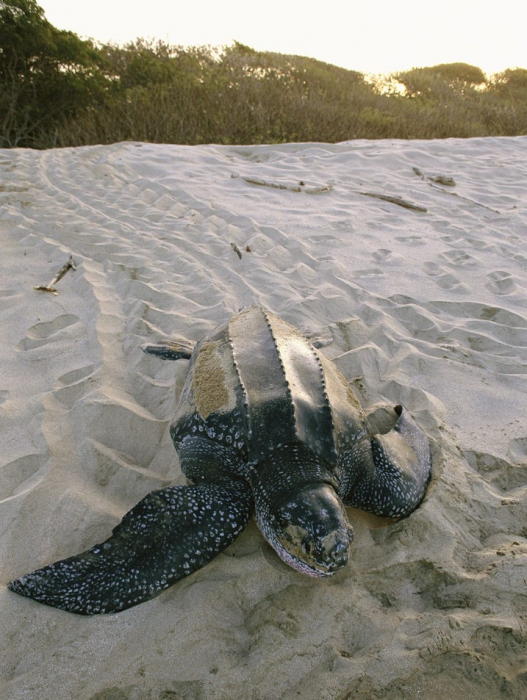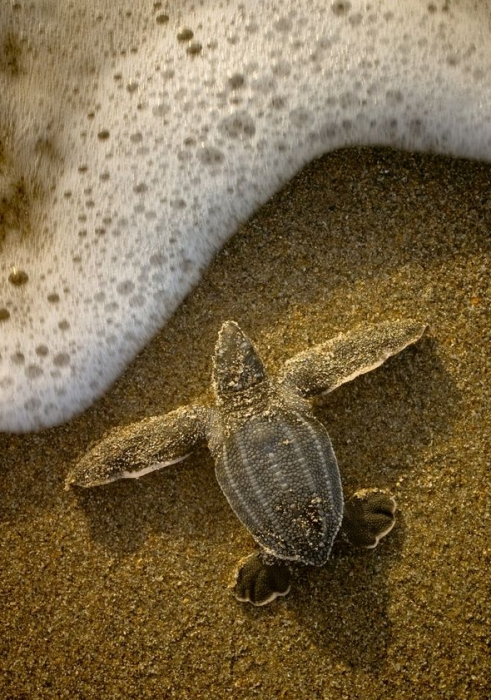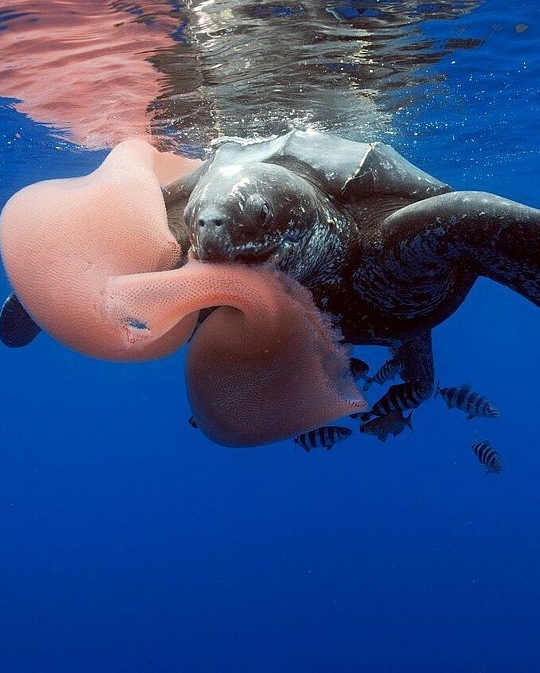The largest turtle in the world is recognized as loot or leatherback turtle. This is the only species in the Dermochelyidae family to date. The first representatives appeared even more than 80 million years ago, in the Campanian age of the Cretaceous period. And since the Triassic (the first geological period of the Mesozoic era), their evolution has followed a separate path. For this reason, the Loot have a number of differences from their counterparts.
Material Content:
Description of the species, dimensions and weight
The leatherback turtle (Dermochelys coriacea) has a dark shell color - from brown to brown-black. The young have yellow spots, but with time they disappear and the color becomes uniform.

The uniqueness of these animals lies in the fact that the carapace does not consist of horny shields, as in other types of sea turtles, but is a thick, up to 4 cm, leathery layer. It is formed by fused bone plates. In this case, the pseudocarapax is not associated with the skeleton, has a heart-shaped shape. Along the entire length of the carapace, from the head to the tail of the individual, there are longitudinal convex ridges. On their back there are usually 7 pieces, and on the peritoneal side - 5.
The head of the loot is large and elongated, the jaws are massive, with large, slightly curved teeth. The limbs are in the form of fins, with the front ones almost twice as large as the rear ones. The animal does not have claws.
Interesting fact. Unlike most of its relatives, the Loot are not able to completely retract their heads into the shell.
The total body length of the largest measured representative of this species was 2.6 meters, the span of the front flippers was 2.5 meters, and weight was 916 kg. According to other data, the indicators were 2.5 m / 5 m / 600 kg, respectively.
Habitat, lifestyle and breeding

The largest turtle lives in tropical seas, but sometimes representatives of the species are found in temperate and even northern latitudes. The ability of loot to feel comfortable in cold water is explained by the fact that their body temperature is higher than that of relatives, provided that the individual eats regularly. In Russia, these giant animals were seen in the Far East and in the Bering Sea.
Leather turtles are single, they are not inclined to gather in herds. For this reason, they are quite difficult to detect. They are non-aggressive and even shy, but if you cannot hide and the fight is inevitable, the loots can fight back. Representatives of this species are one of the few inhabitants of the deep sea that are not attacked by sharks.
Most of the time, individuals spend in water. During the day they stay closer to the bottom, and at night they float to the surface. Only females are selected on land, and only in order to lay eggs.
This happens once every 1-3 years, and one leatherback turtle can make 4-7 clutches per season, with an interval of 10 days. The female goes ashore, and only at night, and digs a well 1-1.2 m deep. Having lowered the back of the body into the pit, she lays eggs. Some of them are fertilized, the rest (they are smaller in size) - no. The latter, bursting, increase the nesting space. Then the individual fills the well with sand, rams it with flippers and goes into the water. It does not return to the place of masonry.
Turtles hatch after 2 months. In size, they do not exceed a kitten. Young animals on the first day get out of the nest and strive for water. Here a lot of dangers lie in wait for cubs - they can easily become prey for predatory animals and birds, lizards.

Having reached the sea, young turtles first have to hide from underwater inhabitants, who can consider them as food. But this period does not last long, and as they grow, they feel freer. In adults, there are no natural enemies in nature.
What does a leather turtle eat
Loots are omnivores and feed on both plant and animal food. Their diet consists of fish, crabs and crayfish, mollusks, sea worms and algae. They are able to easily cope even with the thick stems of underwater plants. They eat jellyfish with great pleasure, including poisonous ones. At the same time, they can do without food for quite a while without losing activity and not hibernating.

Despite the impressive mass, the leatherback turtle is a wonderful hunter. Slow on land, it is able to reach speeds in water of up to 30 km / h and overcome long distances. It knows how to dive, going into a depth of 600 m. According to some reports, representatives of this species are able to plunge into the water for more than 1000 meters in search of food.
Interesting fact. Loot meat is considered conditionally edible, but cases of poisoning are known. This is due to the fact that the poison of the jellyfish that these individuals eat does not harm them, but remains in the tissues for a long time and can be dangerous for humans.
Life expectancy and conservation status of the species
The lifespan of a leatherback turtle in its natural habitat is from 20 to 50 years. But many individuals die much earlier, and this is due to the fault of man. Loot is hunted not only for meat, but also because of fat. It is widely used in small shipbuilding and for other household needs. And the eggs of these turtles are considered a strong aphrodisiac and are the object of poaching.
In addition, the cause of premature death of loot is often garbage that is dumped into the water. Plastic bottles, plastic bags and other small items of a turtle are often mistaken for edible objects, which leads to digestion and rapid death.

Another reason for the decline in the number of these giant animals was mass tourism. Resort areas are not suitable for comfortable loot accommodation, and public beaches are not suitable for egg laying.
Leather turtles are listed in the international Red Book as a vulnerable species, and various measures have been taken to conserve it. So, in many countries, protected coastal zones are created where females can dig nests and make clutches. At all times, man was the only enemy of the giant reptile, it was he who was responsible for reducing the population, and his task today is to help these amazing creatures survive.












